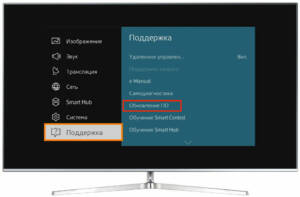- Why is it important to update your TV?
- Performance improvement
- Getting New Features
- Solving problems and eliminating errors
- How to check for updates
- TV settings
- Using the SmartThings app
- How to download and install updates
- Automatic update
- Manual download and installation
- What to do if the update does not install
- Checking your Internet connection
- Clearing the TV cache
- Resetting your TV
- What problems may arise during the update?
- Error downloading update
- Installation problems
- Unexpected changes in settings
- Which TVs can be upgraded?
- List of compatible models
Why is it important to update your TV?
Updating your TV isn't just a new way to watch your favorite shows and movies. There are several reasons why it is important to update your TV. Firstly, new technologies provide better picture and sound. Secondly, upgrading your TV can improve its performance and increase its functionality. For example, many new TVs have Internet connectivity, allowing you to watch high-quality content and use apps. Also, new models may have improved protection against malware and viruses. Third, upgrading your TV can help save energy, as newer models have more efficient lighting systems and use less energy while running. So if you haven't upgraded your TV yet, now is the time to do it.
Performance improvement
One of the most important aspects of upgrading your Samsung TV is improving its performance. Even though your TV can play videos from all over the world, its speed and performance can gradually decrease.
There are several simple and effective ways to improve the performance of your Samsung TV.
1) Clear cache and uninstall unnecessary apps to free up device memory.
2) Turn off features you don't use, such as Bluetooth or Wi-Fi, to free up your TV's resources.
3) Update your TV software. New software versions may improve device performance and fix bugs.
Following these simple tips can greatly improve the performance of your Samsung TV and provide a smoother, more enjoyable experience.
Getting New Features
Updating your Samsung TV is not only about fixing bugs and improving performance, but also about getting new features. To check for updates, you need to go to the “Settings” menu, select “Support” and click on “Software Update”.
If an update is available, you can install it directly from the TV menu. In this case, you should make sure that the device is connected to the Internet. The update may take some time, so it is not recommended to turn off the TV during the process.
After installing the update, the TV will have new features that were previously missing. For example, new features for controlling a TV using a mobile device, support for new video and audio formats, improved work with applications, etc.
d.
Remember to check for updates regularly to get new features and performance improvements for your Samsung TV.
Solving problems and eliminating errors
While updating your Samsung TV, you may encounter some problems and errors. For example, if the update takes too long or the process fails, then you need to take steps to resolve them.
The first step is to check your internet connection, as a slow connection can cause lags and interruptions. If the connection is normal, then you need to make sure that the TV is connected to a power source and turned on. If the problem is still not resolved, you can try restarting the TV and repeating the update process.
If the update is still not successful, then you need to check the availability of free space on your TV, as lack of space can lead to crashes. If there is enough space, then you need to check that the update is compatible with your TV model.
If all the above recommendations do not help, then you can try contacting Samsung support for further assistance.
By following these tips, you will be able to successfully update your Samsung TV without any problems or errors.
How to check for updates
It is important to update your Samsung TV software periodically to ensure optimal performance and correct any errors that may occur. There are several ways to check for updates.
1. Automatic check: If you have the automatic update feature enabled, the TV will automatically check for new updates and install them.
2. Manual check: If you want to check for updates manually, you need to go to the TV menu and select “Software Update”. Then select "Check for updates" and wait while the TV checks for new updates.
3. Using the application: Some Samsung TVs have a special “Samsung Smart View” application that allows you to check for updates and install them directly from your mobile device.
Do not forget that before installing updates, you must save all important data and TV settings. All update processes should only take place if there is a stable Internet connection.
TV settings
After upgrading your TV, you may need to customize it to suit your needs. First check the brightness, contrast and color saturation. Often standard settings do not satisfy users, since everyone has their own taste.
Next, adjust the sound. If it sounds too quiet or too loud, you'll need to change your audio settings to achieve optimal sound quality.
Also, be sure to check your Wi-Fi settings to make sure your TV is connected to the Internet and can use all available features. If your TV is not connected to the Internet, you will not be able to use some features such as Smart TV.
In general, TV settings may vary depending on the model and manufacturer. But, as a rule, setting up a TV does not take much time and is not a difficult task. If you have any problems, you can always contact the manufacturer for help or read the user manual.
Using the SmartThings app
The SmartThings app is a convenient way to control your Samsung devices using your smartphone or tablet. With this app, you can control your TV, air conditioner, refrigerator, washing machine and other Samsung devices even when you are away from home.
To get started with the SmartThings app, you need to download it to your smartphone or tablet from Google Play or the App Store. Then you need to register in the app and add your Samsung devices.
Once you have added your devices, you can manage them through the app. For example, you can turn the TV on or off, change the air conditioner settings, or check the status of your refrigerator.
Additionally, the SmartThings app allows you to create scripts that automatically perform specific actions on your devices. For example, you can create a 'Leaving Home' scenario that automatically turns off all lights, closes windows and doors, and turns off all devices.
Overall, the SmartThings app is a very convenient way to control your Samsung devices and automate some processes. If you have Samsung devices, we highly recommend you try this app.
How to download and install updates
To update your Samsung TV, you need to download the appropriate update from the official Samsung website. To do this, you can use the following instructions:
1. Open a web browser on your computer and go to the Samsung website.
2. Find the 'Support' or 'Technical Support' section and select your TV model.
3. Go to the update download page and find the latest version for your TV model.
4. Download the update file to your computer.
5. Unzip the update file. If the file has the extension .
zip, then you need to unpack it.
6. Copy the update file to a flash drive.
7. Connect the flash drive to the TV's USB port.
8. Press the 'Menu' button on the TV remote control.
9. Select the 'Support' section and select 'Software Update'.
10. The TV will automatically find the update file on the connected flash drive and ask you to confirm the installation.
11. Confirm the installation of the update and wait for the process to complete.
Your Samsung TV is now updated and ready to use. Don't forget to restart your TV after installing the update.
Automatic update
Samsung TVs have a convenient automatic update feature. This feature allows you to update your TV's firmware without having to download and install updates manually.
To activate automatic updates, you need to follow a few simple steps. First, go to the Settings menu on your TV. Then select "Software Update" and go to the "Automatic Update" section.
Here you can choose whether you want your TV to update automatically in the background or whether you'll need to confirm each update manually. We recommend choosing automatic update to ensure your TV is always running the latest firmware.
Don't forget that automatic updating requires your TV to be connected to the Internet. If you do not have access to the Internet, you can still update your TV manually by following the instructions in our article “How to update a Samsung TV: detailed instructions.”
Stay tuned for updates so that your TV works at its maximum capabilities and you can enjoy your favorite programs and movies in the best quality.
Manual download and installation
If you do not want to wait for automatic updates, you can use the manual method. To do this, you need to go to the official Samsung website and find the section with TV support. Enter your TV model and find the latest firmware. Download the file to your computer.
Next, you need to prepare a flash drive (USB drive) for installing the firmware. It must be formatted in the FAT32 file system. Transfer the firmware file to the USB flash drive.
Now you can start the installation. Insert the flash drive into the USB port on the TV. Open the menu on your TV and find the “Software Update” section. Select "Update via USB" and follow the onscreen instructions.
After successful installation, the TV will automatically reboot. Do not turn off the power or remove the flash drive until the update process is complete.
Thus, manually updating the firmware is an easy and effective way to keep your TV up to date.
What to do if the update does not install
If you are facing an issue where your Samsung TV update won't install, don't despair. There are always several ways to solve this problem.
1. Check your internet connection: Make sure your TV is connected to the internet and has a stable connection. If you have connection problems, try restarting your router or modem.
2. Clear the cache: Your Samsung TV may be overloaded with cache, which can lead to crashes and errors when updating. Try clearing your TV's cache, restarting it, and trying to install the update again.
3. Try updating manually: If you still can't install the update, try downloading the update from the manufacturer's website and installing it manually. Installation instructions are usually included on the website.
4. Contact support: If you are still having problems installing the update, please contact Samsung support. They can help you resolve the issue and install the update.
Don't worry if your Samsung TV update won't install. Follow these simple steps and you'll be able to enjoy the latest features and improvements to your TV.
Checking your Internet connection
Before updating your Samsung TV, you need to make sure you have an Internet connection. There are several ways to do this:
1. Connect your TV to the Internet via Wi-Fi. To do this, select the Wi-Fi settings section in the TV menu and enter the password for your Wi-Fi network.
2. Connect the TV to the Internet via an Ethernet cable. To do this, you need to connect the cable to your TV and modem or router.
3. Check your Internet connection. To do this, select the 'Network' section in the TV menu and run a connection test. If everything is configured correctly, the TV should successfully connect to the Internet.
Checking your Internet connection is necessary before updating your Samsung TV to avoid problems downloading the update. Check your connection and enjoy impeccable picture and sound quality on your TV!
Clearing the TV cache
Clearing the Samsung TV cache will help increase operating speed and fix possible errors. This is a fairly simple process that does not require additional programs or skills.
1. Start with the remote control. Click on the "Menu" button to open the main menu.
2. Select the “Settings” section and go to “Support”.
3. Inside “Support” you will find the “Self-diagnosis” item, in which you need to select “Clear cache”.
4. Click on the “Clear cache” button to start the process. This may take several minutes, depending on the number of files in the cache.
5. After clearing the cache is completed, restart the TV. You can also disable it for a few minutes to allow the update to take place more fully.
Your Samsung TV is now ready to use in its new updated state. Clearing the cache helps improve performance and eliminate possible problems with the device. Run the process regularly to keep your TV in good condition.
Resetting your TV
If you encounter problems with your Samsung TV, then one of the solutions may be to reset the settings. This is a simple procedure that will help return your TV to its original settings.
To begin, go to the TV settings menu and find the 'Reset settings' item. Select this item and confirm your choice by clicking the 'OK' button. After this, the TV will reboot and all settings will be reset.
Please note that after resetting, all data saved on the TV will be deleted. Therefore, before resetting the settings, it is necessary to save all important files and settings on external media.
Resetting your TV can solve many problems related to incorrect settings or software errors. If the problem persists, then you should contact a specialist for additional help.
What problems may arise during the update?
Updating your Samsung TV may introduce some issues that may make the update process difficult. For example, if you have a poor internet connection, the update may take longer than expected. Additionally, some users may experience compatibility issues when using third-party equipment such as HDMI cables or external storage devices.
Another problem could be the lack of memory on the TV. If you don't have enough free disk space, the update may not install. In this case, you should free up disk space by deleting unnecessary files and applications.
Finally, there is a possibility that the update may cause problems with your TV. If you encounter this problem, try restarting your TV and repeating the update process. If the problem persists, you may need to seek professional help.
Either way, problems may arise, but they can be easily resolved if you prepare properly before upgrading and follow the instructions.
Error downloading update
There are many possible reasons for an update download error. Some of them may be related to problems with the Internet, while others may be related to incorrect TV settings. If you encounter such a problem, the first thing you need to do is make sure that you have a stable Internet connection. If everything is OK with the network, then you should check your TV settings for updates.
To do this, go to the 'Settings' menu and select 'Support'. In this section, you should find the 'Software Update' option and click on it. If an update is available, a message will appear on the screen and you can begin downloading and installing it. If you still encounter an error, then you should contact the service center so that professionals can help you solve the problem.
Don't forget that regularly updating your TV's software is an important aspect of its operation. Updates may contain bug fixes, performance improvements, and new features that will make using your TV more comfortable and convenient.
Installation problems
When updating your Samsung TV, you may encounter some installation issues. One of them is the lack of free space on your TV. To solve this problem, you need to remove unnecessary apps and files from your TV.
Another problem that you may encounter when upgrading your TV is the lack of internet connection. To resolve this issue, you need to check your Internet connection as well as the network settings on your TV.
If the problem with installing the TV update cannot be solved, you can try updating via a USB flash drive. To do this, you need to download the update file from the official Samsung website, then transfer it to a flash drive and connect it to the TV.
If none of the above helps, you need to contact a Samsung service center for further assistance and guidance.
Unexpected changes in settings
When updating your Samsung TV, there may be unexpected changes to settings that may cause confusion for users. However, there is no need to panic because there is a solution to this problem.
First of all, you need to check the software version installed on your TV. To do this, go to the settings menu and select 'About TV'. If the software version is outdated, you need to update it to the latest version.
After updating the software, some settings may be changed. For example, sound, brightness, contrast, and Internet connection settings may be changed. To restore previous settings, you need to go to the settings menu and make the necessary changes in the appropriate sections.
Also, when updating your Samsung TV, new functions and features may be added. For example, new applications can be added, the ability to connect to a smartphone or tablet, and the Internet experience can be improved. To use these new functions, you need to study the operating instructions and configure all the necessary parameters.
Overall, updating a Samsung TV is an important process that allows you to expand the functionality of the device and improve its performance. However, it must be taken into account that during the update the settings may change, so you must check all the settings and make the necessary changes.
Which TVs can be upgraded?
Updating your TV is an important process that will allow you to access new features and improve picture and sound quality. But not all TVs can be updated.
Basically, the update is available for TVs that were released no earlier than 2012. If your TV was released after this year, then you can update it to the latest version.
However, if your TV was released before 2012, then the likelihood of an upgrade is significantly reduced. In this case, it is recommended to contact the service center for detailed advice.
So, before upgrading your TV, make sure it is not older than 2012. If your TV is new, you can update it to the latest version and enjoy new features and improved picture and sound quality.
List of compatible models
If you're planning to update your Samsung TV, make sure your TV model is compatible with the latest software before you begin the process. Below is a list of Samsung TV models that support software updates:
— 2019: RU8000, RU740D, RU7300, RU7100, RU710D, RU6950, RU6900, RU7105, RU7305, RU8005, Q60R, Q70R, Q80R, Q90R, Q900R, LS03R;
— 2018: NU8500, NU8000, NU740D, NU7300, NU7200, NU7100, NU710D, NU6950, NU6900, NU6900B, NU6080, NU6070, NU6000, NU6905, NU7105, NU7305, Q6FN, Q7FN, Q8FN, Q9FN, Q900FN, LS03N;
— 2017: MU8500, MU8000, MU7500, MU7000, MU6500, MU6300, MU6290, MU6200, MU6100, MU6070, MU630D, MU700D, MU750D, MU760D, MU800D, MU9000, Q6F, Q7C, Q7F, Q8C, Q9F, QLED;
— 2016: KU7500, KU7000, KU6500, KU6300, KU6290, KU6270, KU6000, KU6100, KU6600, KS9800, KS9500, KS9000, KS8500, KS8000, KS7500, KS7000.
If your TV model is not listed, contact Samsung support to see if your TV can be updated.
Read further:






